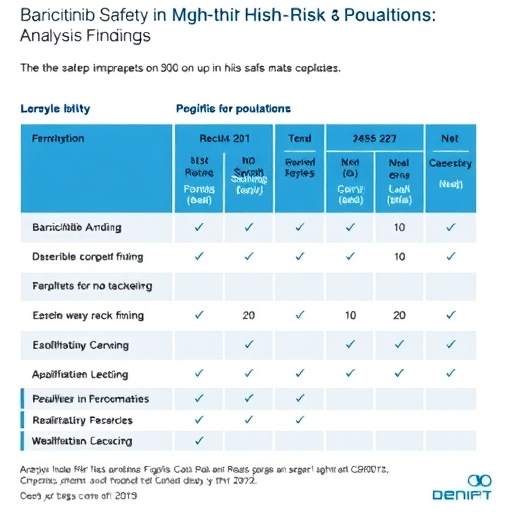In recent years, the realm of therapeutic interventions has burgeoned with innovation, particularly within the domain of autoimmune and inflammatory diseases. One noteworthy advancement is the introduction of Baricitinib, an oral Janus kinase (JAK) inhibitor, which has garnered attention for its effectiveness and safety profile. A pivotal discussion surrounding this medication is encapsulated in the recent correction to an influential analysis, spearheaded by Taylor, P.C., Bieber, T., Alten, R., and their team. This ongoing discourse emphasizes Baricitinib’s application in various rheumatologic and dermatologic conditions, thus inviting scrutiny and insight into its safety for events of special interest within vulnerable populations.
As a therapeutic agent, Baricitinib is specifically designed to modulate immune responses in diseases such as rheumatoid arthritis and atopic dermatitis. Recent findings highlight its potential to alleviate debilitating symptoms while minimizing the risks associated with traditional systemic therapies. However, the importance of understanding the safety profile of Baricitinib, particularly for patients with comorbidities, cannot be overstated. The significance of long-term data derived from randomized trials is central to reassuring both healthcare providers and patients about its usage.
Studies have suggested that while Baricitinib is generally well-tolerated, specific adverse events have been noted, particularly in populations that carry higher risks. This led to the authors revisiting their prior analyses to ensure clarity and accuracy in communicating safety data. The correction itself serves as a critical reminder of the evolving nature of medical knowledge and the necessity for precision in reporting findings. The link between treatment benefits and potential risks is often complex, making transparent communication essential for informed decision-making.
The study’s emphasis on ‘events of special interest’ is particularly relevant, as it highlights the notion that not all adverse events are equal. Certain outcomes, even if infrequent, can lead to significant morbidity and thus warrant closer examination. In this regard, the authors provided a clarifying perspective on which events may be categorized as special interest, emphasizing the multifaceted nature of patient health and the intricacies associated with systemic treatments.
One of the striking features of the correction was the inclusion of stratification based on population risk factors. This stratification is vital, as it allows clinicians to personalize treatment plans for each patient’s unique clinical scenario. By understanding the underlying risk profiles of patients, practitioners can approach Baricitinib’s use with a more nuanced lens, thereby enhancing safety while maximizing therapeutic efficacy.
In navigating the complexities associated with JAK inhibitors, the correction also reaffirms the role of continuous monitoring in clinical settings. Healthcare systems are increasingly reliant on robust pharmacovigilance frameworks to track and respond to adverse events. The proactive engagement of regulatory bodies and the scientific community in tracking post-marketing data are paramount, ensuring that the therapeutic benefits of Baricitinib are not overshadowed by potential risks.
As more patients gain access to Baricitinib, the implications of its safety must be addressed in a comprehensive manner. Real-world data continue to play a crucial role in elucidating long-term outcomes and identifying rare adverse events. The correction serves as a timely reminder of the dynamic interplay between clinical research and patient care, emphasizing the importance of integrating data from randomized trials with real-world evidence.
The authors also underscored the collaborative efforts required among researchers, clinicians, and regulatory organizations to enhance the collective understanding of Baricitinib’s safety profile. These partnerships can lead to refined treatment guidelines, improved patient outcomes, and ultimately a more favorable risk-benefit ratio for individuals rendered vulnerable by autoimmune diseases.
Furthermore, the correction sparks critical dialogue about treatment accessibility and equity. As therapeutic advancements proliferate, attention must also be directed toward ensuring that all patient populations, particularly marginalized communities, can benefit from these innovations. Balancing innovation with equitable accessibility is increasingly recognized as fundamental to ethical medical practice.
The ongoing discourse surrounding Baricitinib epitomizes a larger trend in modern medicine: the focus on personalized treatments that take individual risk profiles into account. Physicians must be equipped not only with clinical data but also with a deep understanding of their patients’ unique circumstances. This holistic approach can lead to more informed discussions about the risks and benefits of treatment choices.
In conclusion, the correction by Taylor et al. serves as a vital contribution to the evolving narrative of Baricitinib’s safety in special populations at risk. By fostering ongoing communication, emphasizing the nuances of data interpretation, and advocating for collaborative efforts, the medical community can navigate the complexities of autoimmune treatment with greater confidence. As new research unfolds, continuous engagement and scrutiny will be imperative in refining therapeutic strategies that prioritize both efficacy and patient safety.
Subject of Research: Safety of Baricitinib in Populations at Risk
Article Title: Correction to: Baricitinib Safety for Events of Special Interest in Populations at Risk: Analysis from Randomised Trial Data Across Rheumatologic and Dermatologic Indications.
Article References:
Taylor, P.C., Bieber, T., Alten, R. et al. Correction to: Baricitinib Safety for Events of Special Interest in Populations at Risk: Analysis from Randomised Trial Data Across Rheumatologic and Dermatologic Indications.
Adv Ther (2025). https://doi.org/10.1007/s12325-025-03244-1
Image Credits: AI Generated
DOI: N/A
Keywords: Baricitinib, JAK inhibitors, safety, autoimmune diseases, patients at risk, randomized trials, pharmacovigilance.




